Impact of M&A on Shareholder Wealth in EU Banking (2005-2017)
VerifiedAdded on 2023/06/10
|33
|9703
|167
Report
AI Summary
This report provides a detailed analysis of the impact of mergers and acquisitions (M&A) on shareholder wealth in the EU banking sector between 2005 and 2017. The research examines the motives behind M&A activity, including horizontal, vertical, and conglomerate mergers, and identifies key determinants influencing these transactions. Using an event study methodology, the report assesses the short, medium, and long-term effects of M&A on stock returns, revealing no significant impact on shareholder wealth in the short run, but a moderate amount of wealth generation in the long run. The study investigates market-based and accounting-based performance metrics, providing insights into the efficiency and operating performance of banks post-merger. The report concludes with recommendations for future research and offers practical implications for financial institutions considering M&A strategies. The research also includes an introduction, literature review, methodology, data analysis, and discussion of findings.
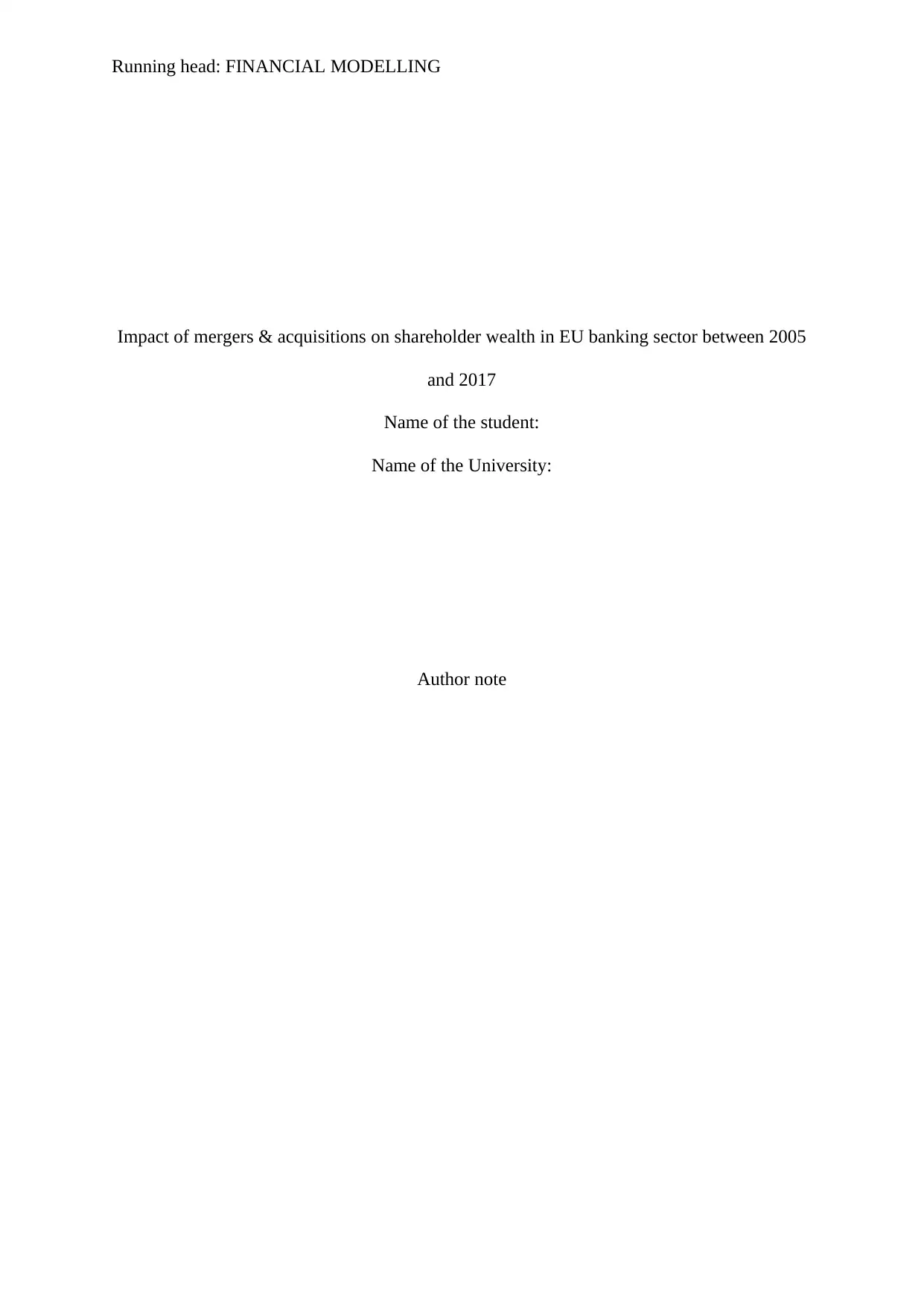
Running head: FINANCIAL MODELLING
Impact of mergers & acquisitions on shareholder wealth in EU banking sector between 2005
and 2017
Name of the student:
Name of the University:
Author note
Impact of mergers & acquisitions on shareholder wealth in EU banking sector between 2005
and 2017
Name of the student:
Name of the University:
Author note
Paraphrase This Document
Need a fresh take? Get an instant paraphrase of this document with our AI Paraphraser
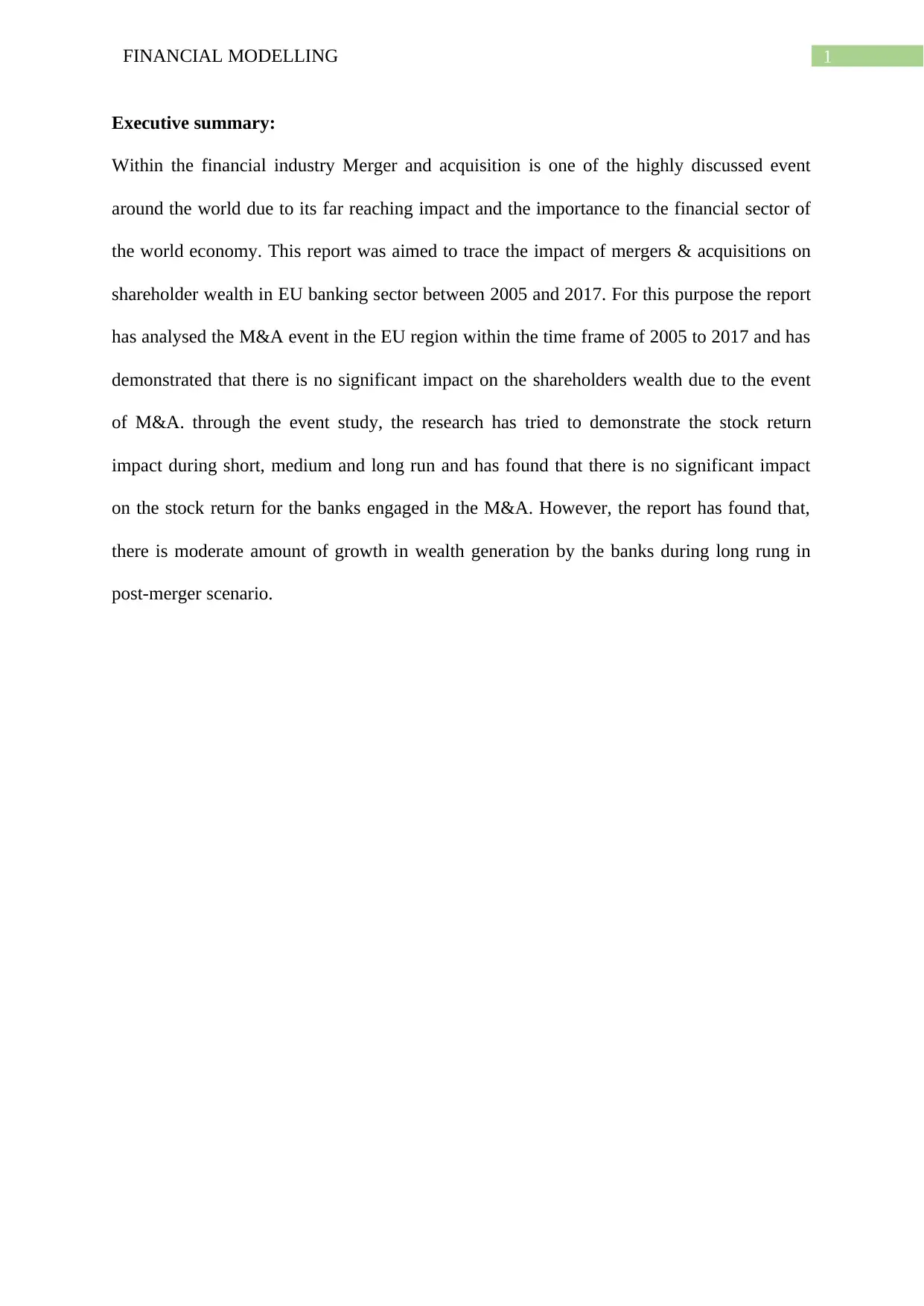
1FINANCIAL MODELLING
Executive summary:
Within the financial industry Merger and acquisition is one of the highly discussed event
around the world due to its far reaching impact and the importance to the financial sector of
the world economy. This report was aimed to trace the impact of mergers & acquisitions on
shareholder wealth in EU banking sector between 2005 and 2017. For this purpose the report
has analysed the M&A event in the EU region within the time frame of 2005 to 2017 and has
demonstrated that there is no significant impact on the shareholders wealth due to the event
of M&A. through the event study, the research has tried to demonstrate the stock return
impact during short, medium and long run and has found that there is no significant impact
on the stock return for the banks engaged in the M&A. However, the report has found that,
there is moderate amount of growth in wealth generation by the banks during long rung in
post-merger scenario.
Executive summary:
Within the financial industry Merger and acquisition is one of the highly discussed event
around the world due to its far reaching impact and the importance to the financial sector of
the world economy. This report was aimed to trace the impact of mergers & acquisitions on
shareholder wealth in EU banking sector between 2005 and 2017. For this purpose the report
has analysed the M&A event in the EU region within the time frame of 2005 to 2017 and has
demonstrated that there is no significant impact on the shareholders wealth due to the event
of M&A. through the event study, the research has tried to demonstrate the stock return
impact during short, medium and long run and has found that there is no significant impact
on the stock return for the banks engaged in the M&A. However, the report has found that,
there is moderate amount of growth in wealth generation by the banks during long rung in
post-merger scenario.
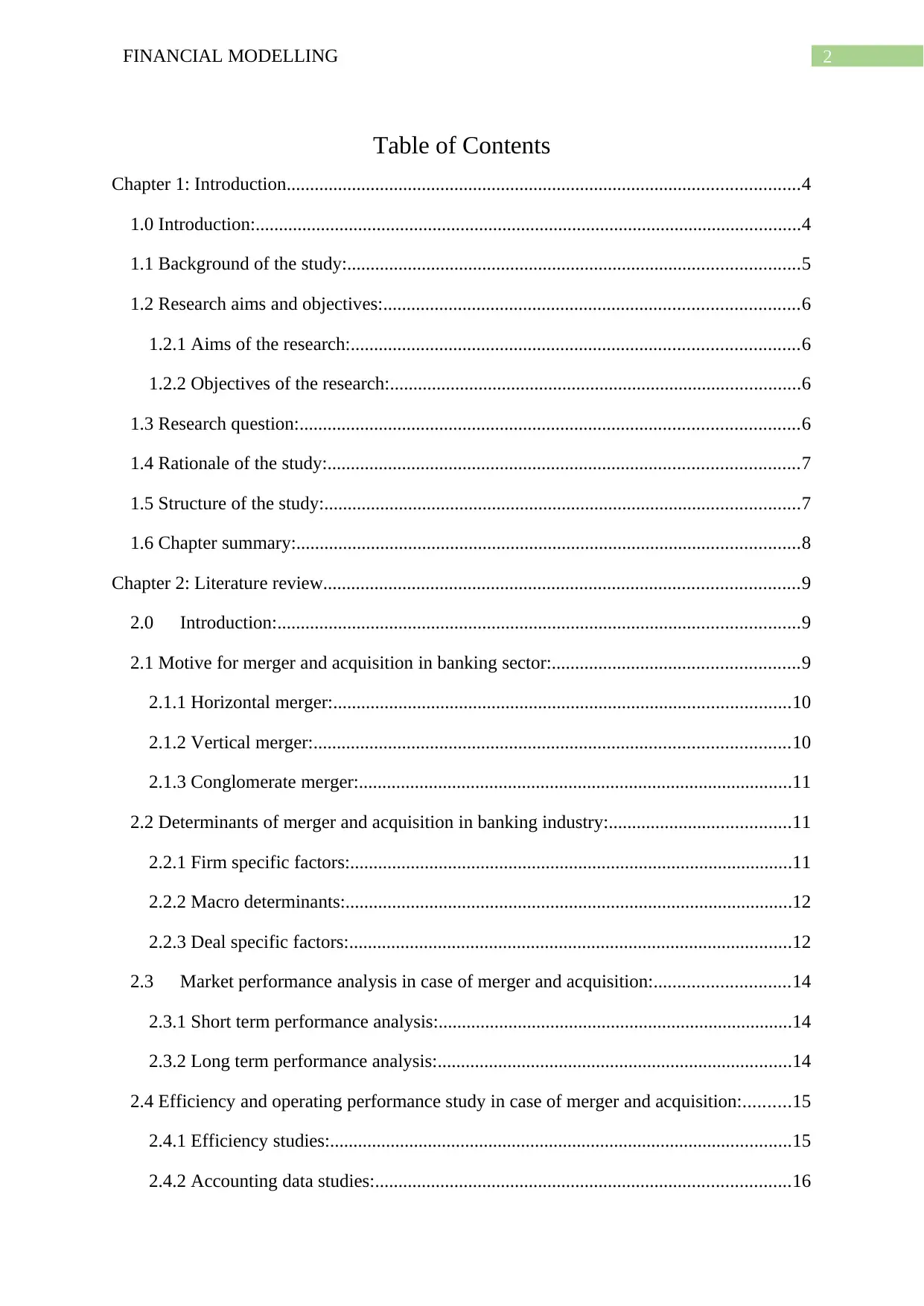
2FINANCIAL MODELLING
Table of Contents
Chapter 1: Introduction..............................................................................................................4
1.0 Introduction:.....................................................................................................................4
1.1 Background of the study:.................................................................................................5
1.2 Research aims and objectives:.........................................................................................6
1.2.1 Aims of the research:................................................................................................6
1.2.2 Objectives of the research:........................................................................................6
1.3 Research question:...........................................................................................................6
1.4 Rationale of the study:.....................................................................................................7
1.5 Structure of the study:......................................................................................................7
1.6 Chapter summary:............................................................................................................8
Chapter 2: Literature review......................................................................................................9
2.0 Introduction:................................................................................................................9
2.1 Motive for merger and acquisition in banking sector:.....................................................9
2.1.1 Horizontal merger:..................................................................................................10
2.1.2 Vertical merger:......................................................................................................10
2.1.3 Conglomerate merger:.............................................................................................11
2.2 Determinants of merger and acquisition in banking industry:.......................................11
2.2.1 Firm specific factors:...............................................................................................11
2.2.2 Macro determinants:................................................................................................12
2.2.3 Deal specific factors:...............................................................................................12
2.3 Market performance analysis in case of merger and acquisition:.............................14
2.3.1 Short term performance analysis:............................................................................14
2.3.2 Long term performance analysis:............................................................................14
2.4 Efficiency and operating performance study in case of merger and acquisition:..........15
2.4.1 Efficiency studies:...................................................................................................15
2.4.2 Accounting data studies:.........................................................................................16
Table of Contents
Chapter 1: Introduction..............................................................................................................4
1.0 Introduction:.....................................................................................................................4
1.1 Background of the study:.................................................................................................5
1.2 Research aims and objectives:.........................................................................................6
1.2.1 Aims of the research:................................................................................................6
1.2.2 Objectives of the research:........................................................................................6
1.3 Research question:...........................................................................................................6
1.4 Rationale of the study:.....................................................................................................7
1.5 Structure of the study:......................................................................................................7
1.6 Chapter summary:............................................................................................................8
Chapter 2: Literature review......................................................................................................9
2.0 Introduction:................................................................................................................9
2.1 Motive for merger and acquisition in banking sector:.....................................................9
2.1.1 Horizontal merger:..................................................................................................10
2.1.2 Vertical merger:......................................................................................................10
2.1.3 Conglomerate merger:.............................................................................................11
2.2 Determinants of merger and acquisition in banking industry:.......................................11
2.2.1 Firm specific factors:...............................................................................................11
2.2.2 Macro determinants:................................................................................................12
2.2.3 Deal specific factors:...............................................................................................12
2.3 Market performance analysis in case of merger and acquisition:.............................14
2.3.1 Short term performance analysis:............................................................................14
2.3.2 Long term performance analysis:............................................................................14
2.4 Efficiency and operating performance study in case of merger and acquisition:..........15
2.4.1 Efficiency studies:...................................................................................................15
2.4.2 Accounting data studies:.........................................................................................16
⊘ This is a preview!⊘
Do you want full access?
Subscribe today to unlock all pages.

Trusted by 1+ million students worldwide
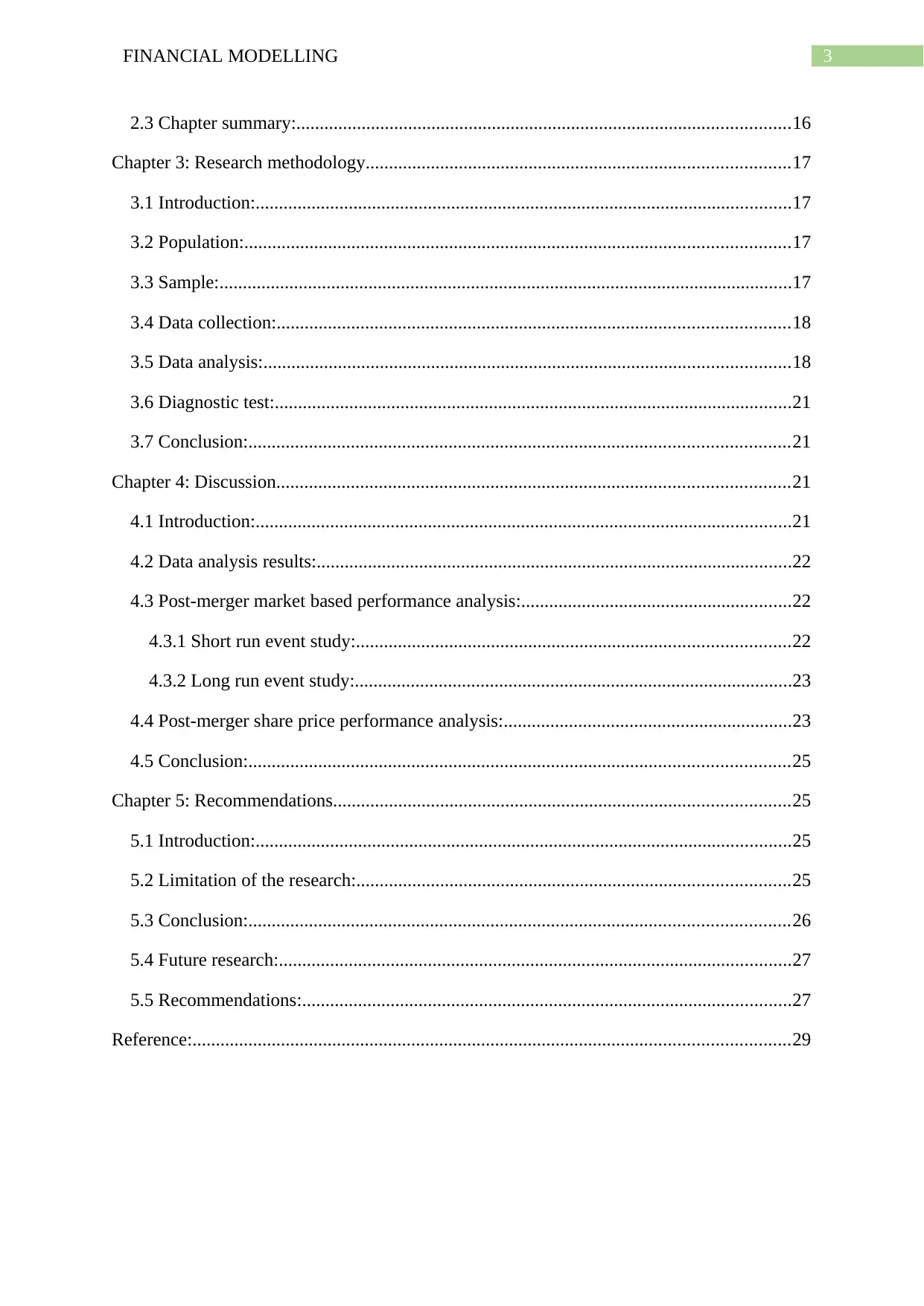
3FINANCIAL MODELLING
2.3 Chapter summary:..........................................................................................................16
Chapter 3: Research methodology...........................................................................................17
3.1 Introduction:...................................................................................................................17
3.2 Population:.....................................................................................................................17
3.3 Sample:...........................................................................................................................17
3.4 Data collection:..............................................................................................................18
3.5 Data analysis:.................................................................................................................18
3.6 Diagnostic test:...............................................................................................................21
3.7 Conclusion:....................................................................................................................21
Chapter 4: Discussion..............................................................................................................21
4.1 Introduction:...................................................................................................................21
4.2 Data analysis results:......................................................................................................22
4.3 Post-merger market based performance analysis:..........................................................22
4.3.1 Short run event study:.............................................................................................22
4.3.2 Long run event study:..............................................................................................23
4.4 Post-merger share price performance analysis:..............................................................23
4.5 Conclusion:....................................................................................................................25
Chapter 5: Recommendations..................................................................................................25
5.1 Introduction:...................................................................................................................25
5.2 Limitation of the research:.............................................................................................25
5.3 Conclusion:....................................................................................................................26
5.4 Future research:..............................................................................................................27
5.5 Recommendations:.........................................................................................................27
Reference:................................................................................................................................29
2.3 Chapter summary:..........................................................................................................16
Chapter 3: Research methodology...........................................................................................17
3.1 Introduction:...................................................................................................................17
3.2 Population:.....................................................................................................................17
3.3 Sample:...........................................................................................................................17
3.4 Data collection:..............................................................................................................18
3.5 Data analysis:.................................................................................................................18
3.6 Diagnostic test:...............................................................................................................21
3.7 Conclusion:....................................................................................................................21
Chapter 4: Discussion..............................................................................................................21
4.1 Introduction:...................................................................................................................21
4.2 Data analysis results:......................................................................................................22
4.3 Post-merger market based performance analysis:..........................................................22
4.3.1 Short run event study:.............................................................................................22
4.3.2 Long run event study:..............................................................................................23
4.4 Post-merger share price performance analysis:..............................................................23
4.5 Conclusion:....................................................................................................................25
Chapter 5: Recommendations..................................................................................................25
5.1 Introduction:...................................................................................................................25
5.2 Limitation of the research:.............................................................................................25
5.3 Conclusion:....................................................................................................................26
5.4 Future research:..............................................................................................................27
5.5 Recommendations:.........................................................................................................27
Reference:................................................................................................................................29
Paraphrase This Document
Need a fresh take? Get an instant paraphrase of this document with our AI Paraphraser
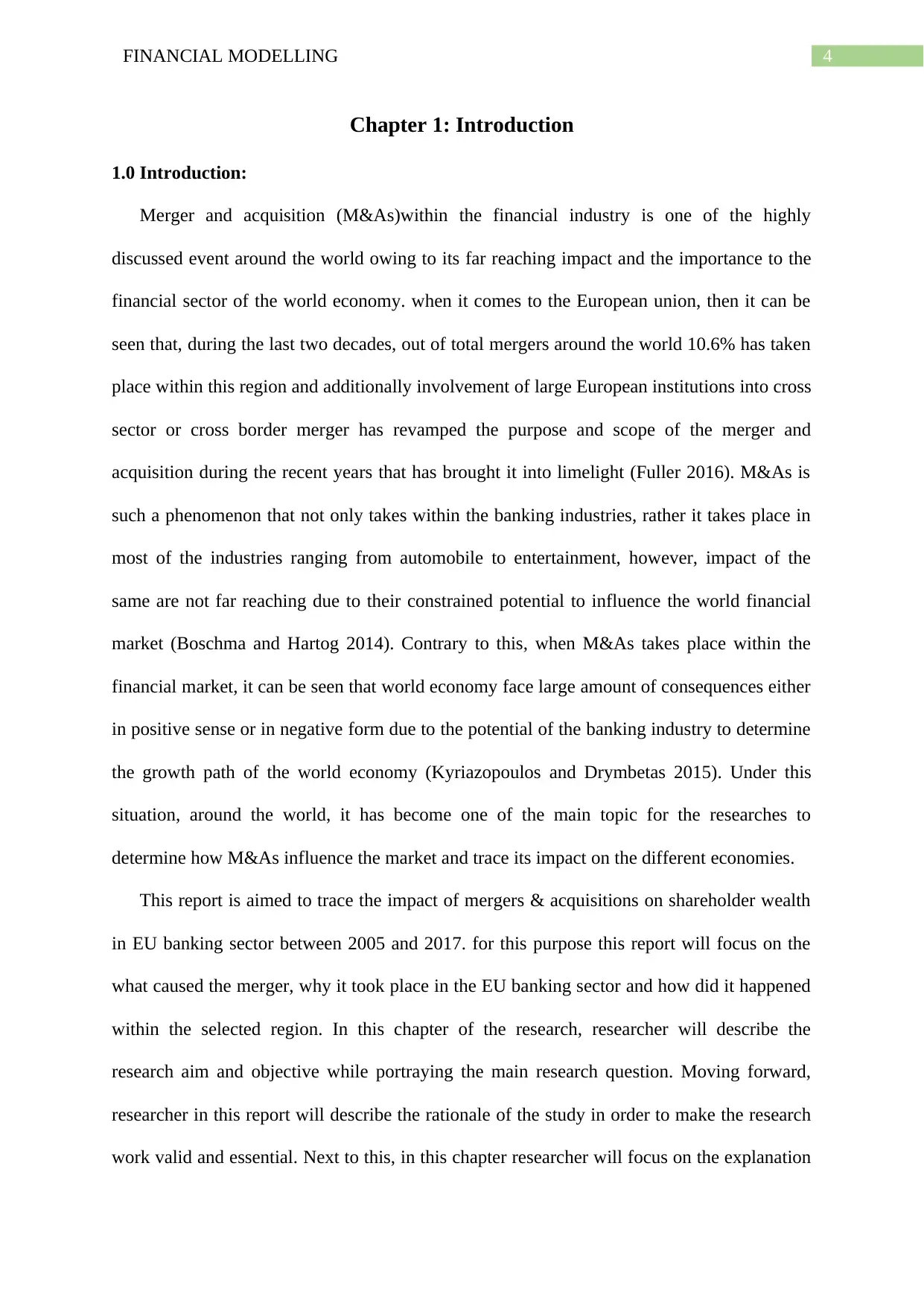
4FINANCIAL MODELLING
Chapter 1: Introduction
1.0 Introduction:
Merger and acquisition (M&As)within the financial industry is one of the highly
discussed event around the world owing to its far reaching impact and the importance to the
financial sector of the world economy. when it comes to the European union, then it can be
seen that, during the last two decades, out of total mergers around the world 10.6% has taken
place within this region and additionally involvement of large European institutions into cross
sector or cross border merger has revamped the purpose and scope of the merger and
acquisition during the recent years that has brought it into limelight (Fuller 2016). M&As is
such a phenomenon that not only takes within the banking industries, rather it takes place in
most of the industries ranging from automobile to entertainment, however, impact of the
same are not far reaching due to their constrained potential to influence the world financial
market (Boschma and Hartog 2014). Contrary to this, when M&As takes place within the
financial market, it can be seen that world economy face large amount of consequences either
in positive sense or in negative form due to the potential of the banking industry to determine
the growth path of the world economy (Kyriazopoulos and Drymbetas 2015). Under this
situation, around the world, it has become one of the main topic for the researches to
determine how M&As influence the market and trace its impact on the different economies.
This report is aimed to trace the impact of mergers & acquisitions on shareholder wealth
in EU banking sector between 2005 and 2017. for this purpose this report will focus on the
what caused the merger, why it took place in the EU banking sector and how did it happened
within the selected region. In this chapter of the research, researcher will describe the
research aim and objective while portraying the main research question. Moving forward,
researcher in this report will describe the rationale of the study in order to make the research
work valid and essential. Next to this, in this chapter researcher will focus on the explanation
Chapter 1: Introduction
1.0 Introduction:
Merger and acquisition (M&As)within the financial industry is one of the highly
discussed event around the world owing to its far reaching impact and the importance to the
financial sector of the world economy. when it comes to the European union, then it can be
seen that, during the last two decades, out of total mergers around the world 10.6% has taken
place within this region and additionally involvement of large European institutions into cross
sector or cross border merger has revamped the purpose and scope of the merger and
acquisition during the recent years that has brought it into limelight (Fuller 2016). M&As is
such a phenomenon that not only takes within the banking industries, rather it takes place in
most of the industries ranging from automobile to entertainment, however, impact of the
same are not far reaching due to their constrained potential to influence the world financial
market (Boschma and Hartog 2014). Contrary to this, when M&As takes place within the
financial market, it can be seen that world economy face large amount of consequences either
in positive sense or in negative form due to the potential of the banking industry to determine
the growth path of the world economy (Kyriazopoulos and Drymbetas 2015). Under this
situation, around the world, it has become one of the main topic for the researches to
determine how M&As influence the market and trace its impact on the different economies.
This report is aimed to trace the impact of mergers & acquisitions on shareholder wealth
in EU banking sector between 2005 and 2017. for this purpose this report will focus on the
what caused the merger, why it took place in the EU banking sector and how did it happened
within the selected region. In this chapter of the research, researcher will describe the
research aim and objective while portraying the main research question. Moving forward,
researcher in this report will describe the rationale of the study in order to make the research
work valid and essential. Next to this, in this chapter researcher will focus on the explanation
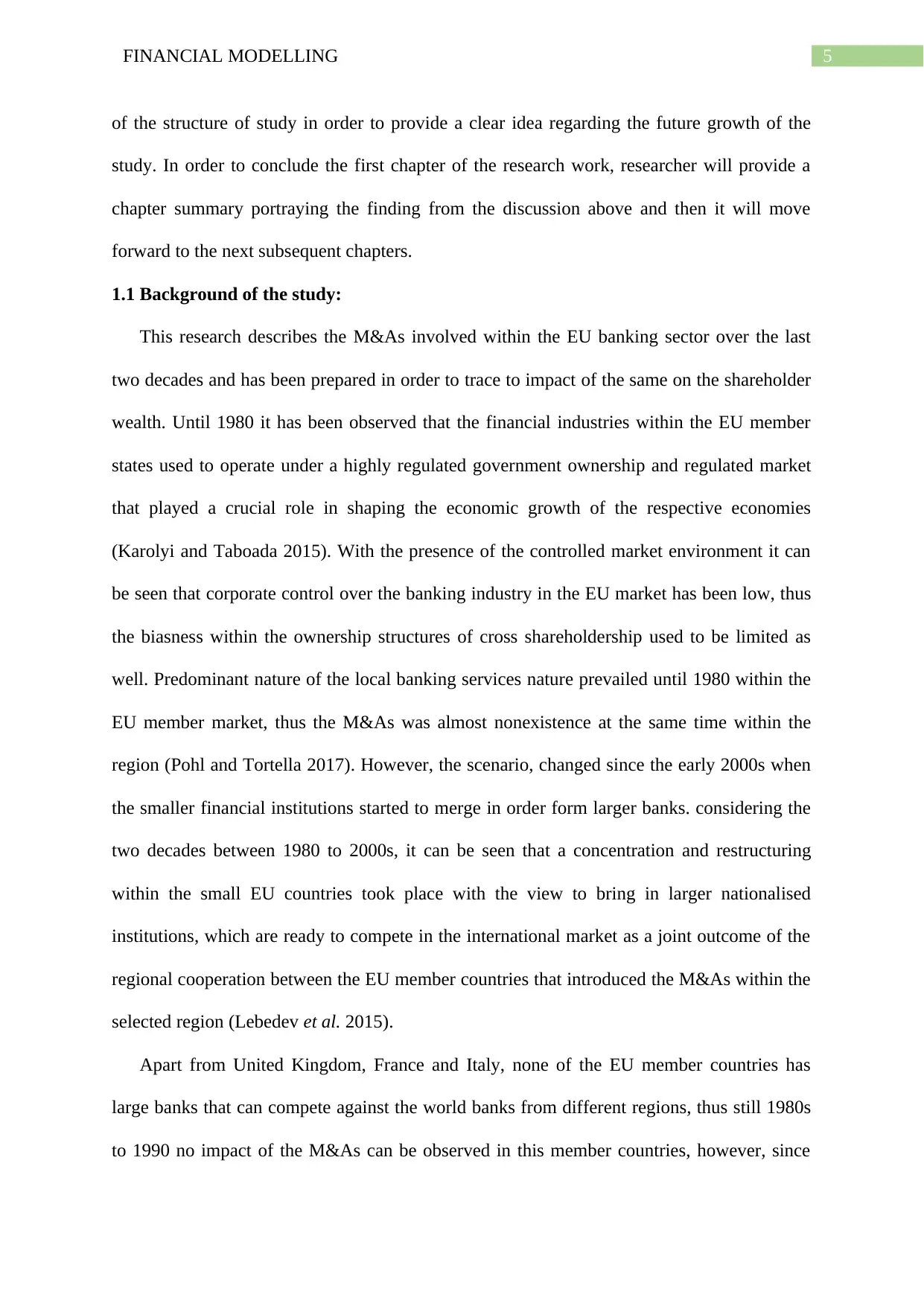
5FINANCIAL MODELLING
of the structure of study in order to provide a clear idea regarding the future growth of the
study. In order to conclude the first chapter of the research work, researcher will provide a
chapter summary portraying the finding from the discussion above and then it will move
forward to the next subsequent chapters.
1.1 Background of the study:
This research describes the M&As involved within the EU banking sector over the last
two decades and has been prepared in order to trace to impact of the same on the shareholder
wealth. Until 1980 it has been observed that the financial industries within the EU member
states used to operate under a highly regulated government ownership and regulated market
that played a crucial role in shaping the economic growth of the respective economies
(Karolyi and Taboada 2015). With the presence of the controlled market environment it can
be seen that corporate control over the banking industry in the EU market has been low, thus
the biasness within the ownership structures of cross shareholdership used to be limited as
well. Predominant nature of the local banking services nature prevailed until 1980 within the
EU member market, thus the M&As was almost nonexistence at the same time within the
region (Pohl and Tortella 2017). However, the scenario, changed since the early 2000s when
the smaller financial institutions started to merge in order form larger banks. considering the
two decades between 1980 to 2000s, it can be seen that a concentration and restructuring
within the small EU countries took place with the view to bring in larger nationalised
institutions, which are ready to compete in the international market as a joint outcome of the
regional cooperation between the EU member countries that introduced the M&As within the
selected region (Lebedev et al. 2015).
Apart from United Kingdom, France and Italy, none of the EU member countries has
large banks that can compete against the world banks from different regions, thus still 1980s
to 1990 no impact of the M&As can be observed in this member countries, however, since
of the structure of study in order to provide a clear idea regarding the future growth of the
study. In order to conclude the first chapter of the research work, researcher will provide a
chapter summary portraying the finding from the discussion above and then it will move
forward to the next subsequent chapters.
1.1 Background of the study:
This research describes the M&As involved within the EU banking sector over the last
two decades and has been prepared in order to trace to impact of the same on the shareholder
wealth. Until 1980 it has been observed that the financial industries within the EU member
states used to operate under a highly regulated government ownership and regulated market
that played a crucial role in shaping the economic growth of the respective economies
(Karolyi and Taboada 2015). With the presence of the controlled market environment it can
be seen that corporate control over the banking industry in the EU market has been low, thus
the biasness within the ownership structures of cross shareholdership used to be limited as
well. Predominant nature of the local banking services nature prevailed until 1980 within the
EU member market, thus the M&As was almost nonexistence at the same time within the
region (Pohl and Tortella 2017). However, the scenario, changed since the early 2000s when
the smaller financial institutions started to merge in order form larger banks. considering the
two decades between 1980 to 2000s, it can be seen that a concentration and restructuring
within the small EU countries took place with the view to bring in larger nationalised
institutions, which are ready to compete in the international market as a joint outcome of the
regional cooperation between the EU member countries that introduced the M&As within the
selected region (Lebedev et al. 2015).
Apart from United Kingdom, France and Italy, none of the EU member countries has
large banks that can compete against the world banks from different regions, thus still 1980s
to 1990 no impact of the M&As can be observed in this member countries, however, since
⊘ This is a preview!⊘
Do you want full access?
Subscribe today to unlock all pages.

Trusted by 1+ million students worldwide
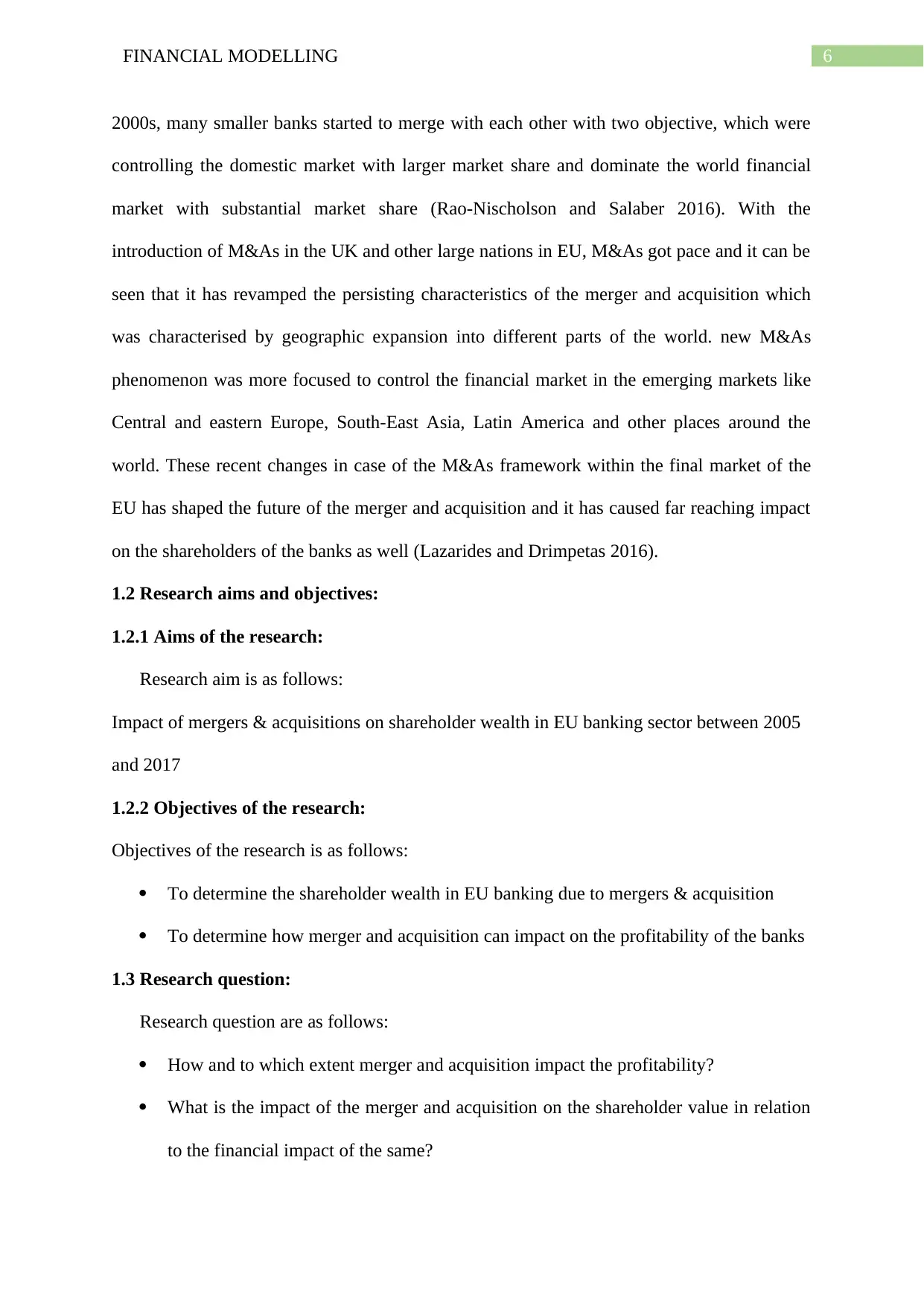
6FINANCIAL MODELLING
2000s, many smaller banks started to merge with each other with two objective, which were
controlling the domestic market with larger market share and dominate the world financial
market with substantial market share (Rao-Nischolson and Salaber 2016). With the
introduction of M&As in the UK and other large nations in EU, M&As got pace and it can be
seen that it has revamped the persisting characteristics of the merger and acquisition which
was characterised by geographic expansion into different parts of the world. new M&As
phenomenon was more focused to control the financial market in the emerging markets like
Central and eastern Europe, South-East Asia, Latin America and other places around the
world. These recent changes in case of the M&As framework within the final market of the
EU has shaped the future of the merger and acquisition and it has caused far reaching impact
on the shareholders of the banks as well (Lazarides and Drimpetas 2016).
1.2 Research aims and objectives:
1.2.1 Aims of the research:
Research aim is as follows:
Impact of mergers & acquisitions on shareholder wealth in EU banking sector between 2005
and 2017
1.2.2 Objectives of the research:
Objectives of the research is as follows:
To determine the shareholder wealth in EU banking due to mergers & acquisition
To determine how merger and acquisition can impact on the profitability of the banks
1.3 Research question:
Research question are as follows:
How and to which extent merger and acquisition impact the profitability?
What is the impact of the merger and acquisition on the shareholder value in relation
to the financial impact of the same?
2000s, many smaller banks started to merge with each other with two objective, which were
controlling the domestic market with larger market share and dominate the world financial
market with substantial market share (Rao-Nischolson and Salaber 2016). With the
introduction of M&As in the UK and other large nations in EU, M&As got pace and it can be
seen that it has revamped the persisting characteristics of the merger and acquisition which
was characterised by geographic expansion into different parts of the world. new M&As
phenomenon was more focused to control the financial market in the emerging markets like
Central and eastern Europe, South-East Asia, Latin America and other places around the
world. These recent changes in case of the M&As framework within the final market of the
EU has shaped the future of the merger and acquisition and it has caused far reaching impact
on the shareholders of the banks as well (Lazarides and Drimpetas 2016).
1.2 Research aims and objectives:
1.2.1 Aims of the research:
Research aim is as follows:
Impact of mergers & acquisitions on shareholder wealth in EU banking sector between 2005
and 2017
1.2.2 Objectives of the research:
Objectives of the research is as follows:
To determine the shareholder wealth in EU banking due to mergers & acquisition
To determine how merger and acquisition can impact on the profitability of the banks
1.3 Research question:
Research question are as follows:
How and to which extent merger and acquisition impact the profitability?
What is the impact of the merger and acquisition on the shareholder value in relation
to the financial impact of the same?
Paraphrase This Document
Need a fresh take? Get an instant paraphrase of this document with our AI Paraphraser
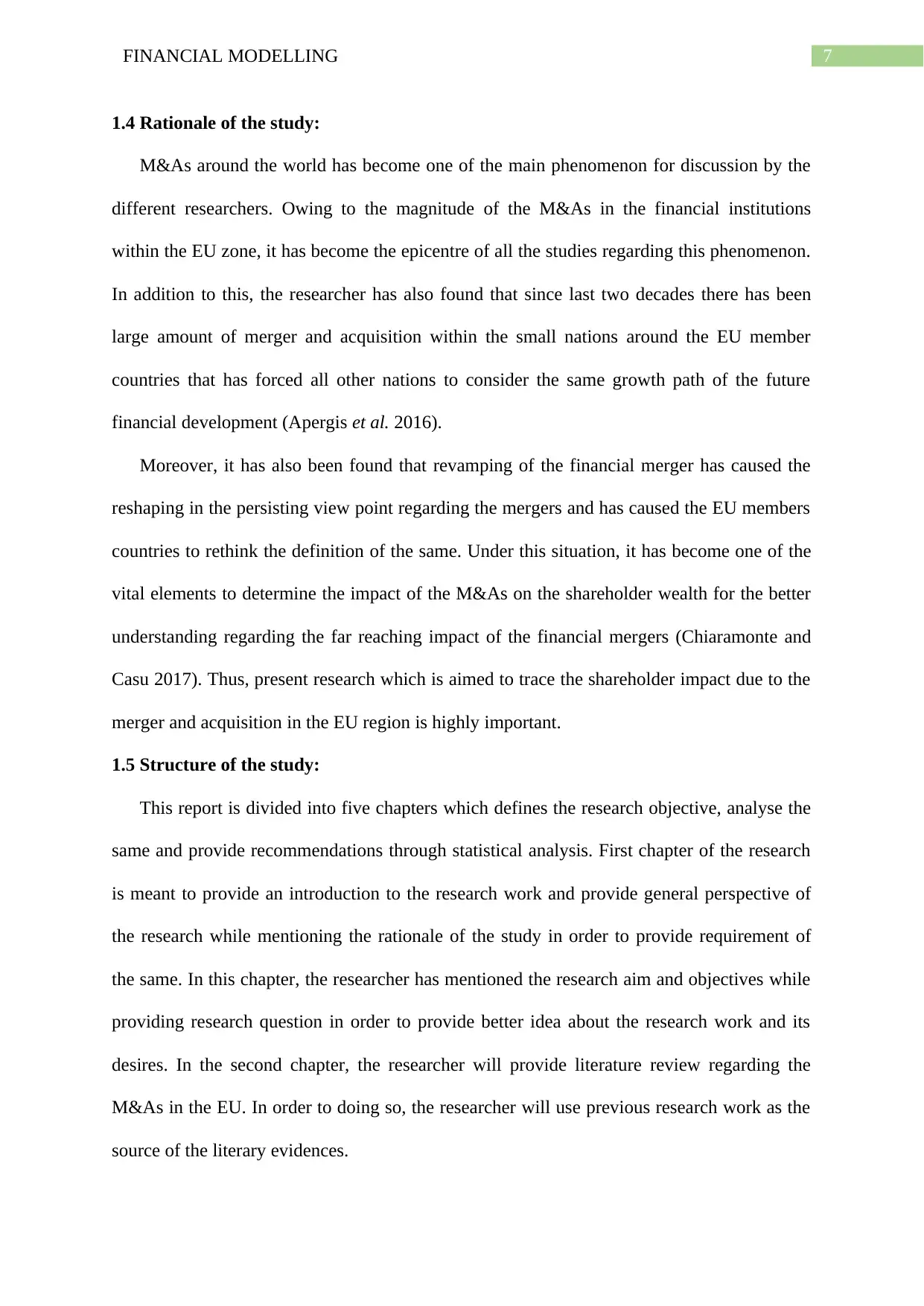
7FINANCIAL MODELLING
1.4 Rationale of the study:
M&As around the world has become one of the main phenomenon for discussion by the
different researchers. Owing to the magnitude of the M&As in the financial institutions
within the EU zone, it has become the epicentre of all the studies regarding this phenomenon.
In addition to this, the researcher has also found that since last two decades there has been
large amount of merger and acquisition within the small nations around the EU member
countries that has forced all other nations to consider the same growth path of the future
financial development (Apergis et al. 2016).
Moreover, it has also been found that revamping of the financial merger has caused the
reshaping in the persisting view point regarding the mergers and has caused the EU members
countries to rethink the definition of the same. Under this situation, it has become one of the
vital elements to determine the impact of the M&As on the shareholder wealth for the better
understanding regarding the far reaching impact of the financial mergers (Chiaramonte and
Casu 2017). Thus, present research which is aimed to trace the shareholder impact due to the
merger and acquisition in the EU region is highly important.
1.5 Structure of the study:
This report is divided into five chapters which defines the research objective, analyse the
same and provide recommendations through statistical analysis. First chapter of the research
is meant to provide an introduction to the research work and provide general perspective of
the research while mentioning the rationale of the study in order to provide requirement of
the same. In this chapter, the researcher has mentioned the research aim and objectives while
providing research question in order to provide better idea about the research work and its
desires. In the second chapter, the researcher will provide literature review regarding the
M&As in the EU. In order to doing so, the researcher will use previous research work as the
source of the literary evidences.
1.4 Rationale of the study:
M&As around the world has become one of the main phenomenon for discussion by the
different researchers. Owing to the magnitude of the M&As in the financial institutions
within the EU zone, it has become the epicentre of all the studies regarding this phenomenon.
In addition to this, the researcher has also found that since last two decades there has been
large amount of merger and acquisition within the small nations around the EU member
countries that has forced all other nations to consider the same growth path of the future
financial development (Apergis et al. 2016).
Moreover, it has also been found that revamping of the financial merger has caused the
reshaping in the persisting view point regarding the mergers and has caused the EU members
countries to rethink the definition of the same. Under this situation, it has become one of the
vital elements to determine the impact of the M&As on the shareholder wealth for the better
understanding regarding the far reaching impact of the financial mergers (Chiaramonte and
Casu 2017). Thus, present research which is aimed to trace the shareholder impact due to the
merger and acquisition in the EU region is highly important.
1.5 Structure of the study:
This report is divided into five chapters which defines the research objective, analyse the
same and provide recommendations through statistical analysis. First chapter of the research
is meant to provide an introduction to the research work and provide general perspective of
the research while mentioning the rationale of the study in order to provide requirement of
the same. In this chapter, the researcher has mentioned the research aim and objectives while
providing research question in order to provide better idea about the research work and its
desires. In the second chapter, the researcher will provide literature review regarding the
M&As in the EU. In order to doing so, the researcher will use previous research work as the
source of the literary evidences.
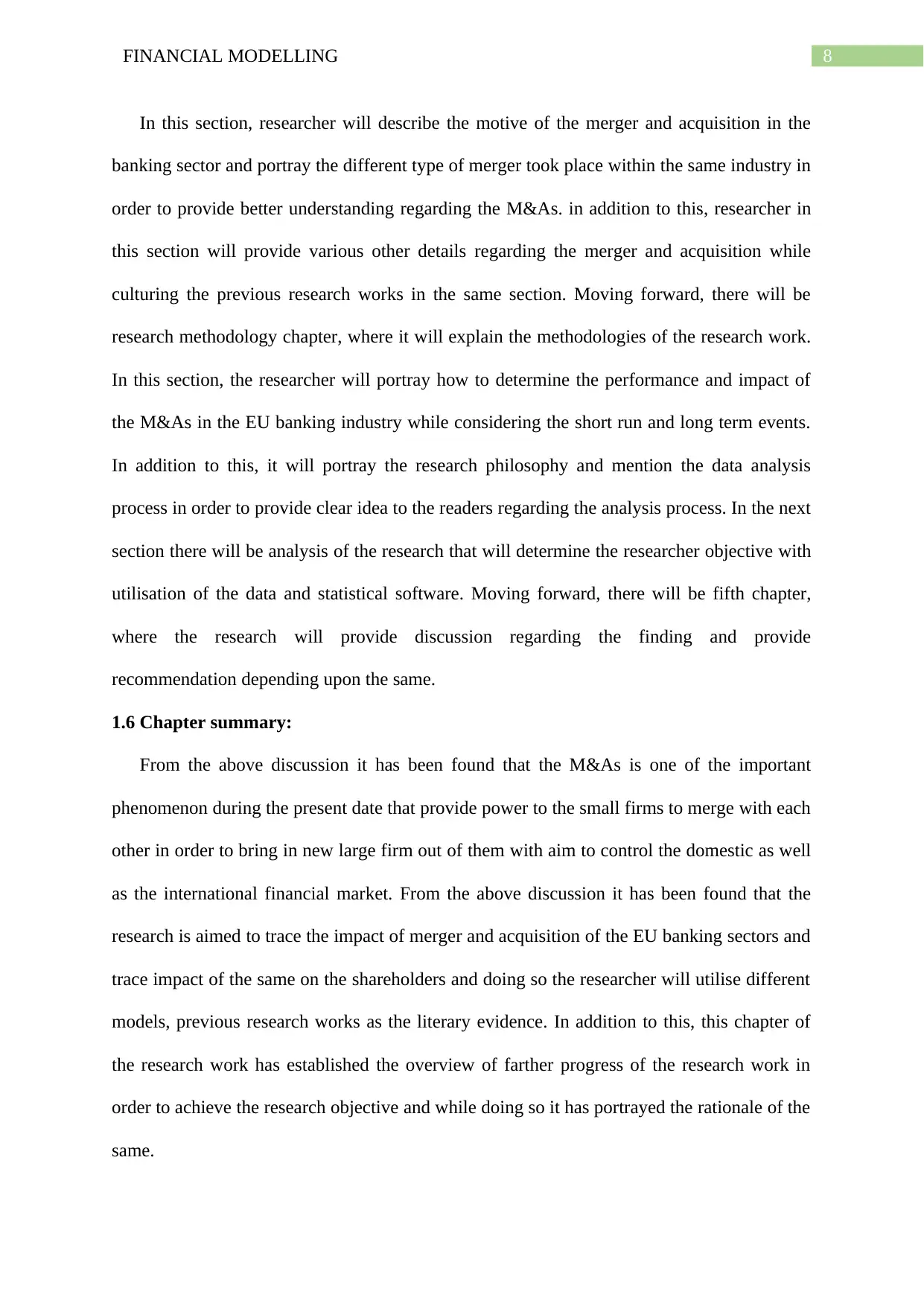
8FINANCIAL MODELLING
In this section, researcher will describe the motive of the merger and acquisition in the
banking sector and portray the different type of merger took place within the same industry in
order to provide better understanding regarding the M&As. in addition to this, researcher in
this section will provide various other details regarding the merger and acquisition while
culturing the previous research works in the same section. Moving forward, there will be
research methodology chapter, where it will explain the methodologies of the research work.
In this section, the researcher will portray how to determine the performance and impact of
the M&As in the EU banking industry while considering the short run and long term events.
In addition to this, it will portray the research philosophy and mention the data analysis
process in order to provide clear idea to the readers regarding the analysis process. In the next
section there will be analysis of the research that will determine the researcher objective with
utilisation of the data and statistical software. Moving forward, there will be fifth chapter,
where the research will provide discussion regarding the finding and provide
recommendation depending upon the same.
1.6 Chapter summary:
From the above discussion it has been found that the M&As is one of the important
phenomenon during the present date that provide power to the small firms to merge with each
other in order to bring in new large firm out of them with aim to control the domestic as well
as the international financial market. From the above discussion it has been found that the
research is aimed to trace the impact of merger and acquisition of the EU banking sectors and
trace impact of the same on the shareholders and doing so the researcher will utilise different
models, previous research works as the literary evidence. In addition to this, this chapter of
the research work has established the overview of farther progress of the research work in
order to achieve the research objective and while doing so it has portrayed the rationale of the
same.
In this section, researcher will describe the motive of the merger and acquisition in the
banking sector and portray the different type of merger took place within the same industry in
order to provide better understanding regarding the M&As. in addition to this, researcher in
this section will provide various other details regarding the merger and acquisition while
culturing the previous research works in the same section. Moving forward, there will be
research methodology chapter, where it will explain the methodologies of the research work.
In this section, the researcher will portray how to determine the performance and impact of
the M&As in the EU banking industry while considering the short run and long term events.
In addition to this, it will portray the research philosophy and mention the data analysis
process in order to provide clear idea to the readers regarding the analysis process. In the next
section there will be analysis of the research that will determine the researcher objective with
utilisation of the data and statistical software. Moving forward, there will be fifth chapter,
where the research will provide discussion regarding the finding and provide
recommendation depending upon the same.
1.6 Chapter summary:
From the above discussion it has been found that the M&As is one of the important
phenomenon during the present date that provide power to the small firms to merge with each
other in order to bring in new large firm out of them with aim to control the domestic as well
as the international financial market. From the above discussion it has been found that the
research is aimed to trace the impact of merger and acquisition of the EU banking sectors and
trace impact of the same on the shareholders and doing so the researcher will utilise different
models, previous research works as the literary evidence. In addition to this, this chapter of
the research work has established the overview of farther progress of the research work in
order to achieve the research objective and while doing so it has portrayed the rationale of the
same.
⊘ This is a preview!⊘
Do you want full access?
Subscribe today to unlock all pages.

Trusted by 1+ million students worldwide
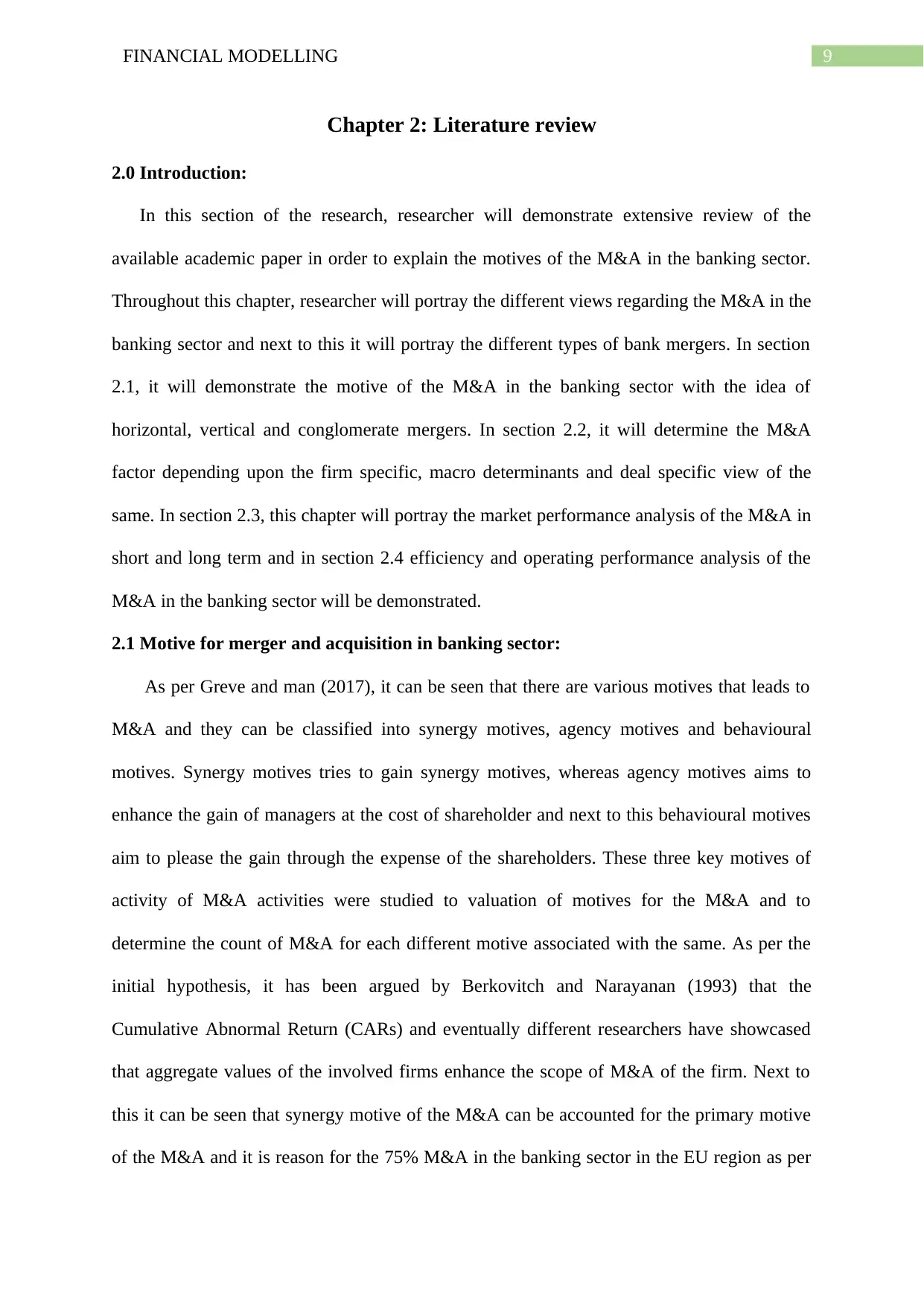
9FINANCIAL MODELLING
Chapter 2: Literature review
2.0 Introduction:
In this section of the research, researcher will demonstrate extensive review of the
available academic paper in order to explain the motives of the M&A in the banking sector.
Throughout this chapter, researcher will portray the different views regarding the M&A in the
banking sector and next to this it will portray the different types of bank mergers. In section
2.1, it will demonstrate the motive of the M&A in the banking sector with the idea of
horizontal, vertical and conglomerate mergers. In section 2.2, it will determine the M&A
factor depending upon the firm specific, macro determinants and deal specific view of the
same. In section 2.3, this chapter will portray the market performance analysis of the M&A in
short and long term and in section 2.4 efficiency and operating performance analysis of the
M&A in the banking sector will be demonstrated.
2.1 Motive for merger and acquisition in banking sector:
As per Greve and man (2017), it can be seen that there are various motives that leads to
M&A and they can be classified into synergy motives, agency motives and behavioural
motives. Synergy motives tries to gain synergy motives, whereas agency motives aims to
enhance the gain of managers at the cost of shareholder and next to this behavioural motives
aim to please the gain through the expense of the shareholders. These three key motives of
activity of M&A activities were studied to valuation of motives for the M&A and to
determine the count of M&A for each different motive associated with the same. As per the
initial hypothesis, it has been argued by Berkovitch and Narayanan (1993) that the
Cumulative Abnormal Return (CARs) and eventually different researchers have showcased
that aggregate values of the involved firms enhance the scope of M&A of the firm. Next to
this it can be seen that synergy motive of the M&A can be accounted for the primary motive
of the M&A and it is reason for the 75% M&A in the banking sector in the EU region as per
Chapter 2: Literature review
2.0 Introduction:
In this section of the research, researcher will demonstrate extensive review of the
available academic paper in order to explain the motives of the M&A in the banking sector.
Throughout this chapter, researcher will portray the different views regarding the M&A in the
banking sector and next to this it will portray the different types of bank mergers. In section
2.1, it will demonstrate the motive of the M&A in the banking sector with the idea of
horizontal, vertical and conglomerate mergers. In section 2.2, it will determine the M&A
factor depending upon the firm specific, macro determinants and deal specific view of the
same. In section 2.3, this chapter will portray the market performance analysis of the M&A in
short and long term and in section 2.4 efficiency and operating performance analysis of the
M&A in the banking sector will be demonstrated.
2.1 Motive for merger and acquisition in banking sector:
As per Greve and man (2017), it can be seen that there are various motives that leads to
M&A and they can be classified into synergy motives, agency motives and behavioural
motives. Synergy motives tries to gain synergy motives, whereas agency motives aims to
enhance the gain of managers at the cost of shareholder and next to this behavioural motives
aim to please the gain through the expense of the shareholders. These three key motives of
activity of M&A activities were studied to valuation of motives for the M&A and to
determine the count of M&A for each different motive associated with the same. As per the
initial hypothesis, it has been argued by Berkovitch and Narayanan (1993) that the
Cumulative Abnormal Return (CARs) and eventually different researchers have showcased
that aggregate values of the involved firms enhance the scope of M&A of the firm. Next to
this it can be seen that synergy motive of the M&A can be accounted for the primary motive
of the M&A and it is reason for the 75% M&A in the banking sector in the EU region as per
Paraphrase This Document
Need a fresh take? Get an instant paraphrase of this document with our AI Paraphraser
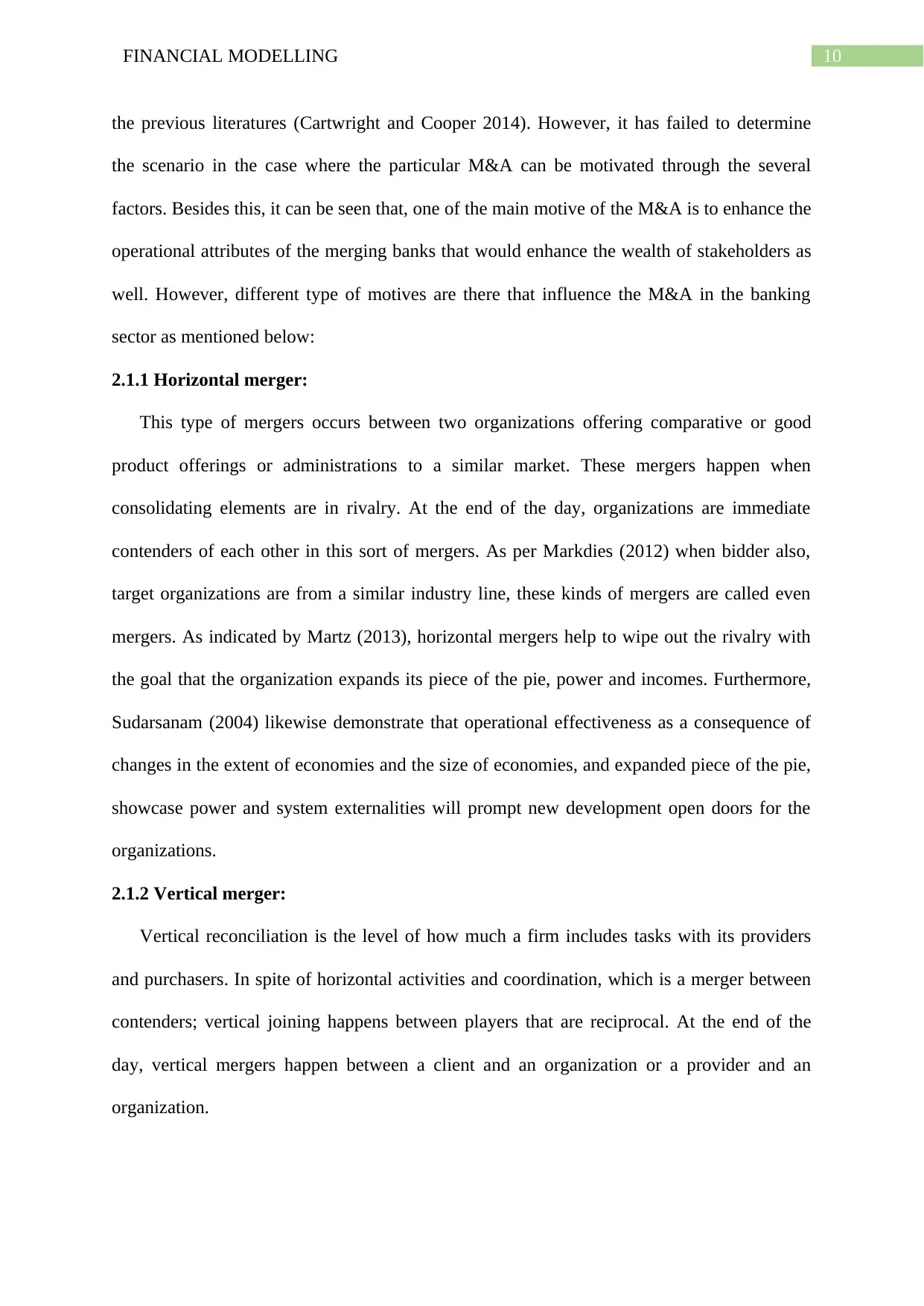
10FINANCIAL MODELLING
the previous literatures (Cartwright and Cooper 2014). However, it has failed to determine
the scenario in the case where the particular M&A can be motivated through the several
factors. Besides this, it can be seen that, one of the main motive of the M&A is to enhance the
operational attributes of the merging banks that would enhance the wealth of stakeholders as
well. However, different type of motives are there that influence the M&A in the banking
sector as mentioned below:
2.1.1 Horizontal merger:
This type of mergers occurs between two organizations offering comparative or good
product offerings or administrations to a similar market. These mergers happen when
consolidating elements are in rivalry. At the end of the day, organizations are immediate
contenders of each other in this sort of mergers. As per Markdies (2012) when bidder also,
target organizations are from a similar industry line, these kinds of mergers are called even
mergers. As indicated by Martz (2013), horizontal mergers help to wipe out the rivalry with
the goal that the organization expands its piece of the pie, power and incomes. Furthermore,
Sudarsanam (2004) likewise demonstrate that operational effectiveness as a consequence of
changes in the extent of economies and the size of economies, and expanded piece of the pie,
showcase power and system externalities will prompt new development open doors for the
organizations.
2.1.2 Vertical merger:
Vertical reconciliation is the level of how much a firm includes tasks with its providers
and purchasers. In spite of horizontal activities and coordination, which is a merger between
contenders; vertical joining happens between players that are reciprocal. At the end of the
day, vertical mergers happen between a client and an organization or a provider and an
organization.
the previous literatures (Cartwright and Cooper 2014). However, it has failed to determine
the scenario in the case where the particular M&A can be motivated through the several
factors. Besides this, it can be seen that, one of the main motive of the M&A is to enhance the
operational attributes of the merging banks that would enhance the wealth of stakeholders as
well. However, different type of motives are there that influence the M&A in the banking
sector as mentioned below:
2.1.1 Horizontal merger:
This type of mergers occurs between two organizations offering comparative or good
product offerings or administrations to a similar market. These mergers happen when
consolidating elements are in rivalry. At the end of the day, organizations are immediate
contenders of each other in this sort of mergers. As per Markdies (2012) when bidder also,
target organizations are from a similar industry line, these kinds of mergers are called even
mergers. As indicated by Martz (2013), horizontal mergers help to wipe out the rivalry with
the goal that the organization expands its piece of the pie, power and incomes. Furthermore,
Sudarsanam (2004) likewise demonstrate that operational effectiveness as a consequence of
changes in the extent of economies and the size of economies, and expanded piece of the pie,
showcase power and system externalities will prompt new development open doors for the
organizations.
2.1.2 Vertical merger:
Vertical reconciliation is the level of how much a firm includes tasks with its providers
and purchasers. In spite of horizontal activities and coordination, which is a merger between
contenders; vertical joining happens between players that are reciprocal. At the end of the
day, vertical mergers happen between a client and an organization or a provider and an
organization.
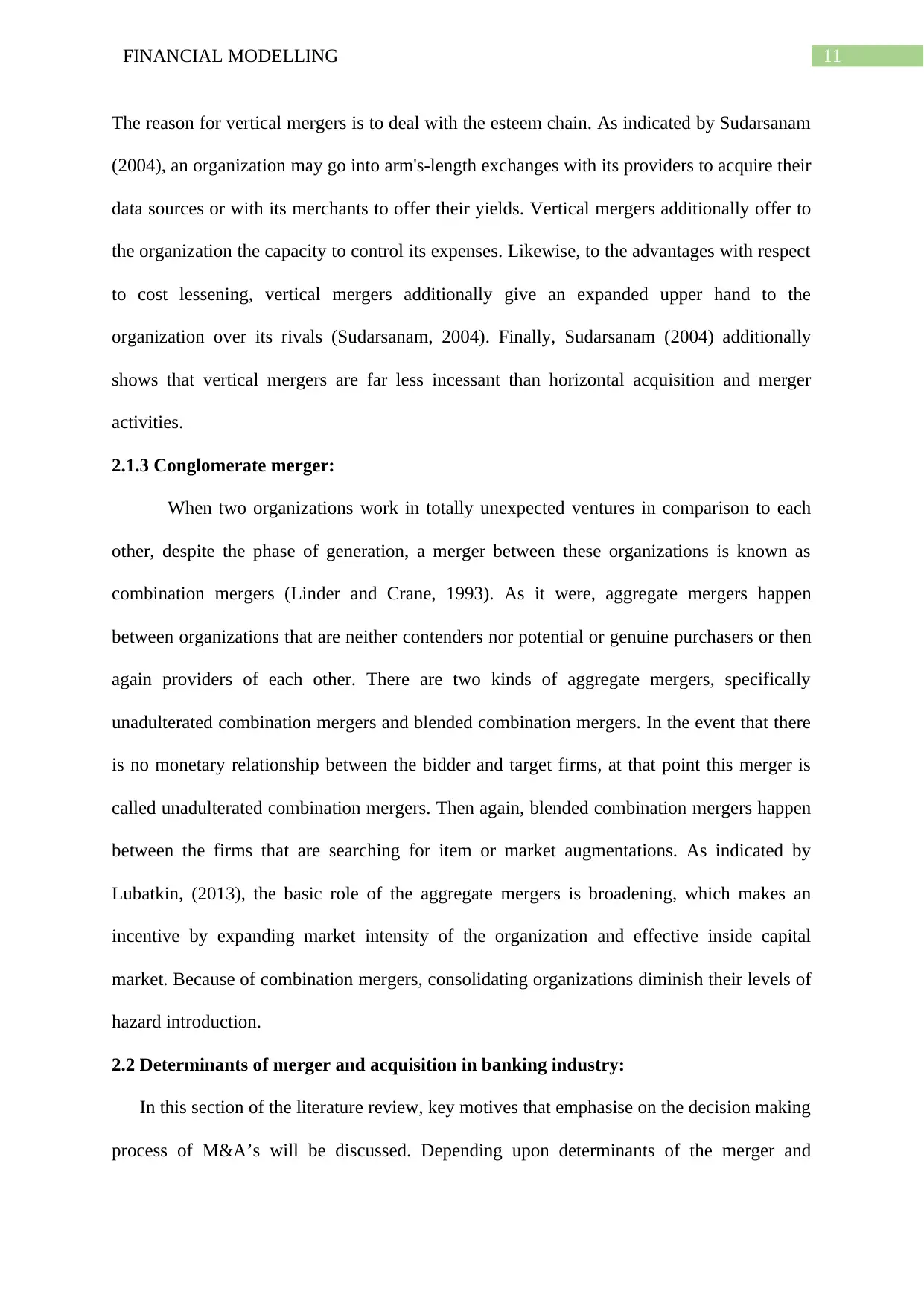
11FINANCIAL MODELLING
The reason for vertical mergers is to deal with the esteem chain. As indicated by Sudarsanam
(2004), an organization may go into arm's-length exchanges with its providers to acquire their
data sources or with its merchants to offer their yields. Vertical mergers additionally offer to
the organization the capacity to control its expenses. Likewise, to the advantages with respect
to cost lessening, vertical mergers additionally give an expanded upper hand to the
organization over its rivals (Sudarsanam, 2004). Finally, Sudarsanam (2004) additionally
shows that vertical mergers are far less incessant than horizontal acquisition and merger
activities.
2.1.3 Conglomerate merger:
When two organizations work in totally unexpected ventures in comparison to each
other, despite the phase of generation, a merger between these organizations is known as
combination mergers (Linder and Crane, 1993). As it were, aggregate mergers happen
between organizations that are neither contenders nor potential or genuine purchasers or then
again providers of each other. There are two kinds of aggregate mergers, specifically
unadulterated combination mergers and blended combination mergers. In the event that there
is no monetary relationship between the bidder and target firms, at that point this merger is
called unadulterated combination mergers. Then again, blended combination mergers happen
between the firms that are searching for item or market augmentations. As indicated by
Lubatkin, (2013), the basic role of the aggregate mergers is broadening, which makes an
incentive by expanding market intensity of the organization and effective inside capital
market. Because of combination mergers, consolidating organizations diminish their levels of
hazard introduction.
2.2 Determinants of merger and acquisition in banking industry:
In this section of the literature review, key motives that emphasise on the decision making
process of M&A’s will be discussed. Depending upon determinants of the merger and
The reason for vertical mergers is to deal with the esteem chain. As indicated by Sudarsanam
(2004), an organization may go into arm's-length exchanges with its providers to acquire their
data sources or with its merchants to offer their yields. Vertical mergers additionally offer to
the organization the capacity to control its expenses. Likewise, to the advantages with respect
to cost lessening, vertical mergers additionally give an expanded upper hand to the
organization over its rivals (Sudarsanam, 2004). Finally, Sudarsanam (2004) additionally
shows that vertical mergers are far less incessant than horizontal acquisition and merger
activities.
2.1.3 Conglomerate merger:
When two organizations work in totally unexpected ventures in comparison to each
other, despite the phase of generation, a merger between these organizations is known as
combination mergers (Linder and Crane, 1993). As it were, aggregate mergers happen
between organizations that are neither contenders nor potential or genuine purchasers or then
again providers of each other. There are two kinds of aggregate mergers, specifically
unadulterated combination mergers and blended combination mergers. In the event that there
is no monetary relationship between the bidder and target firms, at that point this merger is
called unadulterated combination mergers. Then again, blended combination mergers happen
between the firms that are searching for item or market augmentations. As indicated by
Lubatkin, (2013), the basic role of the aggregate mergers is broadening, which makes an
incentive by expanding market intensity of the organization and effective inside capital
market. Because of combination mergers, consolidating organizations diminish their levels of
hazard introduction.
2.2 Determinants of merger and acquisition in banking industry:
In this section of the literature review, key motives that emphasise on the decision making
process of M&A’s will be discussed. Depending upon determinants of the merger and
⊘ This is a preview!⊘
Do you want full access?
Subscribe today to unlock all pages.

Trusted by 1+ million students worldwide
1 out of 33
Related Documents
Your All-in-One AI-Powered Toolkit for Academic Success.
+13062052269
info@desklib.com
Available 24*7 on WhatsApp / Email
![[object Object]](/_next/static/media/star-bottom.7253800d.svg)
Unlock your academic potential
Copyright © 2020–2025 A2Z Services. All Rights Reserved. Developed and managed by ZUCOL.





